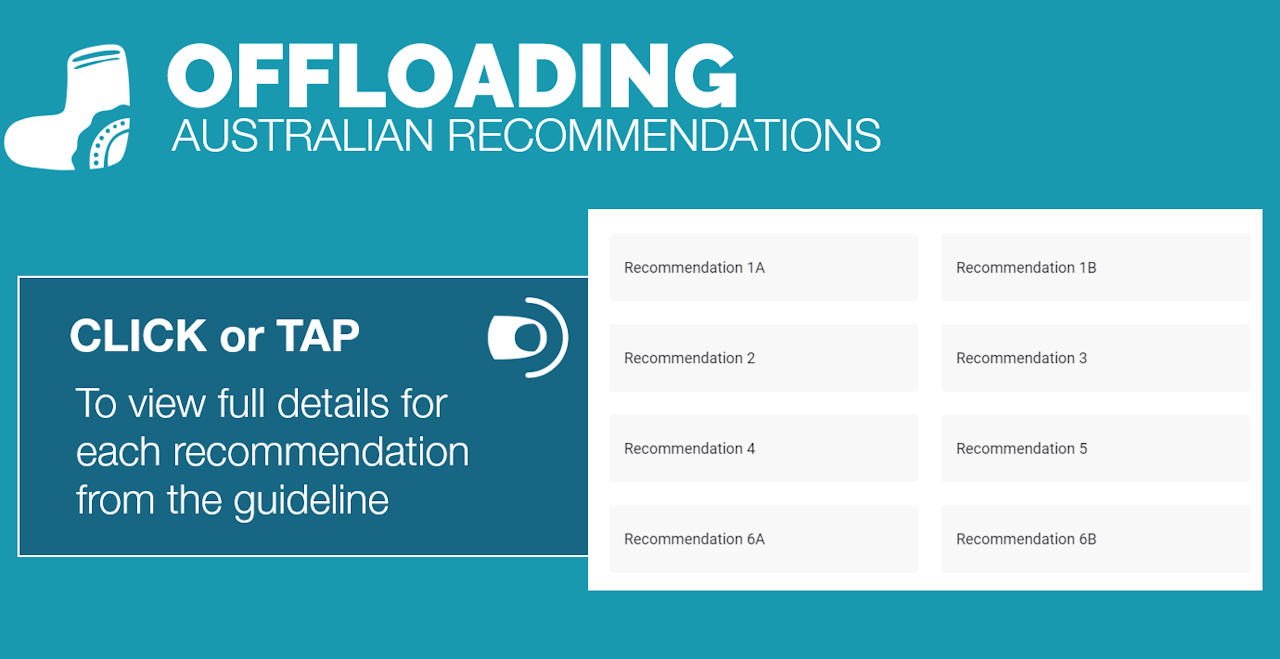

RECOMMENDATION 1A | |
In a person with diabetes and a neuropathic plantar forefoot or midfoot ulcer, use a non-removable knee-high offloading device rather than a removable offloading device to promote healing of the ulcer (GRADE strength of recommendation: Strong; Quality of evidence: Moderate) | |
RECOMMENDATION 1B | |
When using a non-removable knee-high offloading device to heal a neuropathic plantar forefoot or midfoot ulcer in a person with diabetes, consider using either a total contact cast or non-removable knee-high walker, with the choice dependent on the local resources and technical skills available, and the person’s preference and extent of foot deformity (Weak; Low). | |
RECOMMENDATION 2 | |
In a person with diabetes and a neuropathic plantar forefoot or midfoot ulcer, when non-removable knee-high offloading devices are contraindicated or not tolerated, consider using a removable knee-high offloading device (and explain the importance of using) during all weight-bearing activities rather than a removable ankle-high offloading device to reduce plantar pressure and promote healing of the ulcer (Weak; Low) | |
RECOMMENDATION 3 | |
In a person with diabetes and a neuropathic plantar forefoot or midfoot ulcer, when knee-high offloading devices are contraindicated or not tolerated, use a removable ankle-high offloading device (and explain the importance of using) during all weight-bearing activities rather than medical grade footwear to promote healing of the ulcer (Strong; Very low) | |
RECOMMENDATION 4 | |
In a person with diabetes and a neuropathic plantar forefoot or midfoot ulcer, when ankle-high offloading devices are contraindicated or not tolerated, use medical grade footwear rather than other footwear types or no footwear to promote healing of the ulcer (Strong; Low). | |
RECOMMENDATION 5 | |
In a person with diabetes and a neuropathic plantar forefoot or midfoot ulcer, consider using felted foam in combination with an offloading device or footwear rather than using the offloading device or footwear alone to further reduce plantar pressure and promote healing of the ulcer (Weak; Very Low). | |
RECOMMENDATION 6A | |
If the best recommended offloading device option fails to heal a person with diabetes and a neuropathic plantar metatarsal head ulcer, consider using Achilles tendon lengthening or Gastrocnemius recession, metatarsal head resection(s), or joint arthroplasty to promote healing of the ulcer (Weak; Low) | |
RECOMMENDATION 6B | |
If the best recommended offloading device option fails to heal a person with diabetes and a neuropathic plantar or apical ulcer on a non-rigid toe, consider using digital flexor tenotomy to promote healing of the ulcer (Weak; Low) | |
RECOMMENDATION 7A | |
In a person with diabetes and a neuropathic plantar forefoot or midfoot ulcer with either mild infection or mild ischemia, consider using a non-removable knee-high offloading device to promote healing of the ulcer (Weak; Low) | |
RECOMMENDATION 7B | |
In a person with diabetes and a neuropathic plantar forefoot or midfoot ulcer with both mild infection and mild ischemia, or with either moderate infection or moderate ischaemia, consider using a removable knee-high offloading device to promote healing of the ulcer. (Weak; Low) | |
RECOMMENDATION 7C | |
In a person with diabetes and a neuropathic plantar forefoot or midfoot ulcer with both moderate infection and moderate ischaemia, or with either severe infection or severe ischemia, primarily address the infection and/or ischemia, and consider using a removable offloading intervention based on the patient’s functioning, ambulatory status and activity level, to promote healing of the ulcer (Weak; Low | |
RECOMMENDATION 8 | |
In a person with diabetes and a neuropathic plantar heel ulcer, consider using a knee-high offloading device or other offloading intervention that effectively reduces plantar pressure on the heel and is tolerated by the patient, to promote healing of the ulcer. (Weak; Low) | |
RECOMMENDATION 9 | |
In a person with diabetes and a non-plantar foot ulcer, use a removable offloading device, medical grade footwear, felted foam, toe spacers or orthoses, depending on the type and location of the foot ulcer, rather than no offloading intervention to promote healing of the ulcer and to prevent further ulceration (Strong; Very Low) |
